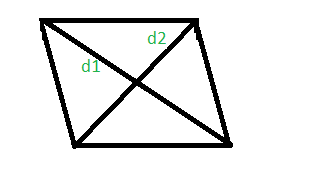Program to calculate area and perimeter of a rhombus whose diagonals are given
Last Updated :
23 Jul, 2022
Given the length of diagonals of a rhombus, d1 and d2. The task is to find the perimeter and the area of that rhombus.
A rhombus is a polygon having 4 equal sides in which both the opposite sides are parallel, and opposite angles are equal.

Examples:
Input: d1 = 2 and d2 = 4
Output: The area of rhombus with diagonals 2 and 4 is 4.
The perimeter of rhombus with diagonals 2 and 4 is 8.
Input: d1 = 100 and d2 = 500
Output: The area of rhombus with diagonals 100 and 500 is 25000.
The perimeter of rhombus with diagonals 100 and 500 is 1019.
Area of the rhombus = 
Perimeterof the rhombus = 
Below is the implementation of above approach:
C++
#include <iostream>
#include <math.h>
using namespace std;
int rhombusAreaPeri(int d1, int d2)
{
long long int area, perimeter;
area = (d1 * d2) / 2;
perimeter = 2 * sqrt(pow(d1, 2) + pow(d2, 2));
cout << "The area of rhombus with diagonals "
<< d1 << " and " << d2 << " is " << area << "." << endl;
cout << "The perimeter of rhombus with diagonals "
<< d1 << " and " << d2 << " is " << perimeter << "." << endl;
}
int main()
{
int d1 = 2, d2 = 4;
rhombusAreaPeri(d1, d2);
return 0;
}
|
Java
import java.io.*;
class GFG {
static int rhombusAreaPeri(int d1, int d2)
{
int area, perimeter;
area = (d1 * d2) / 2;
perimeter = (int)(2 * Math.sqrt(Math.pow(d1, 2) + Math.pow(d2, 2)));
System.out.println( "The area of rhombus with diagonals "
+ d1 + " and " + d2 + " is " + area + ".");
System.out.println("The perimeter of rhombus with diagonals "
+d1 + " and " + d2 + " is " + perimeter + ".");
return 0;
}
public static void main (String[] args) {
int d1 = 2, d2 = 4;
rhombusAreaPeri(d1, d2);
}
}
|
Python3
from math import sqrt, pow
def rhombusAreaPeri(d1, d2):
area = (d1 * d2) / 2
perimeter = 2 * sqrt(pow(d1, 2) +
pow(d2, 2))
print("The area of rhombus with diagonals",
d1, "and", d2, "is", area, ".")
print("The perimeter of rhombus with diagonals",
d1, "and", d2, "is", perimeter, "." )
if __name__ == '__main__':
d1 = 2
d2 = 4
rhombusAreaPeri(d1, d2)
|
C#
using System;
class GFG
{
static int rhombusAreaPeri(int d1,
int d2)
{
int area, perimeter;
area = (d1 * d2) / 2;
perimeter = (int)(2 * Math.Sqrt(Math.Pow(d1, 2) +
Math.Pow(d2, 2)));
Console.WriteLine( "The area of rhombus with " +
"diagonals " + d1 + " and " +
d2 + " is " + area + ".");
Console.WriteLine("The perimeter of rhombus " +
"with diagonals " + d1 + " and " +
d2 + " is " + perimeter + ".");
return 0;
}
public static void Main ()
{
int d1 = 2, d2 = 4;
rhombusAreaPeri(d1, d2);
}
}
|
PHP
<?php
function rhombusAreaPeri($d1, $d2)
{
$area = ($d1 * $d2) / 2;
$perimeter = 2 * sqrt(pow($d1, 2) +
pow($d2, 2));
echo "The area of rhombus with diagonals ". $d1 .
" and " . $d2 . " is " . $area . "." . "\n";
echo "The perimeter of rhombus with diagonals " . $d1 .
" and " . $d2 . " is " . $perimeter . "." . "\n";
}
$d1 = 2; $d2 = 4;
rhombusAreaPeri($d1, $d2);
?>
|
Javascript
<script>
function rhombusAreaPeri(d1, d2)
{
let area, perimeter;
area = Math.floor((d1 * d2) / 2);
perimeter = Math.floor(2 * Math.sqrt(Math.pow(d1, 2) + Math.pow(d2, 2)));
document.write("The area of rhombus with diagonals "
+ d1 + " and " + d2 + " is " + area + "." + "<br>");
document.write("The perimeter of rhombus with diagonals "
+ d1 + " and " + d2 + " is " + perimeter + "." + "<br>");
}
let d1 = 2, d2 = 4;
rhombusAreaPeri(d1, d2);
</script>
|
Output: The area of rhombus with diagonals 2 and 4 is 4.
The perimeter of rhombus with diagonals 2 and 4 is 8.
Time Complexity: O(log(d12+d22))
Auxiliary Space: O(1), since no extra space has been taken.
Share your thoughts in the comments
Please Login to comment...